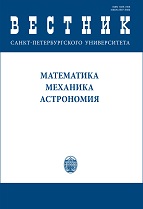|
This article is cited in 1 scientific paper (total in 1 paper)
MECHANICS
Formulation and solution of a generalized Chebyshev problem. II
M. P. Yushkov
St. Petersburg State University, 7-9, Universitetskaya nab., St. Petersburg, 199034, Russian Federation
Abstract:
This work is a continuation of the article "Formulation and solution of a generalized Chebyshev problem. I", in which a generalized Chebyshev problem was formulated, two theories of motion for non-holonomic systems with high-order constraints were presented for its solution. These theories were used to study the motion of the Earth's satellite when fixing the magnitude of its acceleration (this was equivalent to imposing a linear non-holonomic constraint of the third order). In the offered article, the second theory, based on the application of the generalized Gauss principle, is used to solve one of the most important problems of control theory: finding the optimal control force that translates a mechanical system with a finite number of degrees of freedom from one phase state to another in a specified time. The application of the theory is demonstrated by solving a model problem of controlling the horizontal motion of a cart bearing the axes of s mathematical pendulums. Initially, the problem is solved by applying the Pontryagin maximum principle, which minimizes the functional of the square of the desired horizontal control force, which transfers the mechanical system from a state of rest to a new state of rest in the specified time with the horizontal displacement of the cart by S (that is, the problem of vibration damping is considered). Let's call this approach the first method of solving the control problem. It is shown that a linear non-holonomic constraint of the order $(2s + 4)$ is continuously performed. This suggests applying the second theory of motion for non-holonomic systems with high-order constraints to the same problem (see the previous article), developed at the Department of Theoretical and Applied Mechanics of the Faculty of Mathematics and Mechanics of Saint Petersburg State University. Let's call this approach the second method of solving the problem. Calculations performed for the case of $s = 2$ showed that the results obtained by the both methods are practically the same for a short-term motion of the system, while they differ sharply for a long-term motion. This is because the control found using the first method contains harmonics with the system's natural frequencies, which tends to bring the system into resonance. With a short-term motion, this is not noticeable, and with a long-term motion, there are large fluctuations in the system. In contrast, when using the second method, the control is in the form of a polynomial in time, which provides a relatively smooth motion of the system. In addition, in order to eliminate the control force jumps at the beginning and end of the motion, we propose to solve a generalized boundary value problem and discuss some special cases that sometimes occur when using the second method for solving the boundary value problem.
Keywords:
non-holonomic mechanics, high-order constraints, Pontryagin maximum principle, generalized Gauss principle, control, suppression of oscillation, generalized boundary problem.
Received: 13.03.2020
Revised: 05.05.2020
Accepted: 18.07.2020
Citation:
M. P. Yushkov, “Formulation and solution of a generalized Chebyshev problem. II”, Vestnik of Saint Petersburg University. Mathematics. Mechanics. Astronomy, 7:4 (2020), 714–733; Vestn. St. Petersbg. Univ., Math., 7:4 (2020), 459–472
Linking options:
https://www.mathnet.ru/eng/vspua158 https://www.mathnet.ru/eng/vspua/v7/i4/p714
|

| Statistics & downloads: |
| Abstract page: | 51 | | Full-text PDF : | 19 |
|




 Contact us:
Contact us: Terms of Use
Terms of Use
 Registration to the website
Registration to the website Logotypes
Logotypes








 Citation in format
Citation in format 
